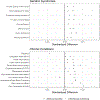Heath status, frailty, and multimorbidity in patients with emergency general surgery conditions
- PMID: 35397953
- PMCID: PMC9232899
- DOI: 10.1016/j.surg.2022.02.011
Heath status, frailty, and multimorbidity in patients with emergency general surgery conditions
Abstract
Background: Although nearly 1 million older adults are admitted for emergency general surgery conditions yearly, the extent to which baseline health influences the development and treatment of emergency general surgery conditions is unknown. We evaluated baseline health and older patients with and without emergency general surgery conditions.
Methods: We used the prospectively collected Medicare Current Beneficiary Survey with Medicare claims and 2 validated health frameworks: (1) Deficit Accumulation Frailty Score and (2) Complex Multimorbidity. Self-reported health and function items were used to derive pre-emergency general surgery conditions Deficit Accumulation Frailty Score and Complex Multimorbidity scores. Deficit Accumulation Frailty Score ranges from 0 (no frailty deficits) to 100 (all possible deficits present). Complex Multimorbidity is a 3-point categorical rank based on the presence of chronic conditions, functional limitations, and geriatric syndromes. Specific survey factors were also examined to determine association with development of emergency general surgery conditions or use of operative management.
Results: Of 54,417 individuals, 1,960 had emergency general surgery conditions (median age 79 [interquartile range 73-84]). Patients with emergency general surgery conditions had significantly higher Deficit Accumulation Frailty Score (19 [interquartile range 11-31] vs 14 [8-24]) and were more likely to be in the most severe Complex Multimorbidity category (38% vs 29%). Emergency general surgery conditions patients had higher proportions of nearly every health category, with the most striking differences in functional limitations. Patients who were treated nonoperatively had the poorest overall baseline health.
Conclusion: Patients who developed emergency general surgery conditions had more severe health burden than patients who did not, particularly in functional status. Clinicians must better understand the interaction between baseline health vulnerability and emergency surgical disease to improve prognostication and ensure alignment of patient goals and treatment strategies.
Copyright © 2022 Elsevier Inc. All rights reserved.
Conflict of interest statement
Conflicts of Interest/Disclosures:
Vanessa P. Ho spouse is a consultant to Medtronic, Zimmer Biomet, Atricure, and Astra Zeneca.
Christopher W. Towe is a consultant to Medtronic, Zimmer Biomet, Atricure, and Astra Zeneca.
Figures



References
-
- Shafi S, Aboutanos MB, Agarwal S Jr., Brown CV, Crandall M, Feliciano DV, et al. Emergency general surgery: definition and estimated burden of disease. J Trauma Acute Care Surg. 2013;74:1092–7. - PubMed
-
- Ogola GO, Gale SC, Haider A, Shafi S. The financial burden of emergency general surgery: National estimates 2010 to 2060. J Trauma Acute Care Surg. 2015;79:444–8. - PubMed
-
- Shah AA, Haider AH, Zogg CK, Schwartz DA, Haut ER, Zafar SN, et al. National estimates of predictors of outcomes for emergency general surgery. J Trauma Acute Care Surg. 2015;78:482–90; discussion 90–1. - PubMed
Publication types
MeSH terms
Grants and funding
LinkOut - more resources
Full Text Sources

